
Cercis canadensis, the eastern redbud, is a large deciduous shrub or small tree, native to eastern North America from southern Michigan south to central Mexico, west to New Mexico. Species thrive as far west as California and as far north as southern Ontario. It is the state tree of Oklahoma. The prevalence of the so-called "Columbus strain" has seen the residents of Columbus, Wisconsin, embrace the plant in their city's identity. Known as the "Redbud City," the town hosts "Redbud Day" annually the Saturday before Mother's Day, organizing a variety of themed events to recognize the tree.

Pulmonaria (lungwort) is a genus of flowering plants in the family Boraginaceae, native to Europe and western Asia, with one species east to central Asia. According to various estimates there may be between 10 and 18 species found in the wild.
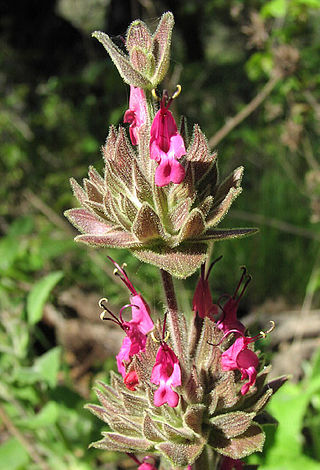
Salvia spathacea, the California hummingbird sage or pitcher sage, is a species of flowering plant in the family Lamiaceae, native to southern and central California growing from sea level to 610 m (2,001 ft). This fruity scented sage blooms in March to May with typically dark rose-lilac colored flowers. It is cultivated in gardens for its attractive flowering spikes and pleasant scent.

Dicentra formosa is a species of flowering plant in the poppy family, Papaveraceae. With its fern-like foliage and inflorescence of drooping pink, purple, yellow or cream "hearts", this species is native to the United States' Pacific Northwest and West Coast of North America.
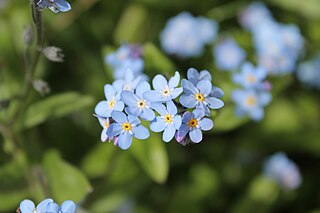
Myosotis sylvatica, the wood forget-me-not or woodland forget-me-not, is a species of flowering plant in the family Boraginaceae, native to Europe. This spring-flowering plant and its cultivars, typically with blue flowers, are the familiar forget-me-nots of gardens.

Galeopsis tetrahit, the common hemp-nettle or brittlestem hempnettle, is a flowering plant in the family Lamiaceae, native to Europe and northwestern Asia.

Salvia pratensis, the meadow clary or meadow sage, is a species of flowering plant in the family Lamiaceae, native to Europe, western Asia and northern Africa. The Latin specific epithet pratensis means "of meadows", referring to its preferred habitat. It also grows in scrub edges and woodland borders.

Bistorta affinis, the Himalayan bistort, fleece flower, or knotweed, is a species of flowering plant in the family Polygonaceae, native to the Himalayas.

Olsynium douglasii is a species of flowering plant in the iris family (Iridaceae). Common names include Douglas' olsynium, Douglas' grasswidow, grass-widow, blue-eyed grass, purple-eyed-grass, and satin flower, It is the only species in the genus Olsynium in North America, the remaining 11 species being from South America. It was formerly treated in the related genus Sisyrinchium. Despite the common names, it is not a true grass (Poaceae).

Phlox subulata the creeping phlox, moss phlox, moss pink or mountain phlox, is a species of flowering plant in the family Polemoniaceae, native to eastern and central USA, and widely cultivated.

Phlox paniculata is a species of flowering plant in the phlox family (Polemoniaceae). It is native to parts of the eastern and central United States. It is extensively cultivated in temperate regions as an ornamental plant and has become established in the wild in scattered locales in other regions. Common names include fall phlox, garden phlox, perennial phlox, summer phlox, and panicled phlox.

Gilia ophthalmoides is a species of flowering plant in the phlox family known by the common name eyed gilia. It is native to the Southwestern United States where it can be found in woodlands and high desert plateau.
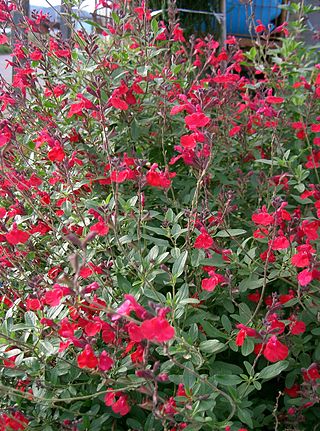
Salvia microphylla, synonyms including Salvia grahamii, Salvia lemmonii and Salvia neurepia, the baby sage, Graham's sage, or blackcurrant sage, is an evergreen shrub found in the wild in southeastern Arizona and the mountains of eastern, western, and southern Mexico. It is a very complex species which easily hybridizes, resulting in numerous hybrids and cultivars brought into horticulture since the 1990s. The specific epithet microphylla, from the Greek, means "small leaved". In Mexico it is called mirto de montes, or "myrtle of the mountains".
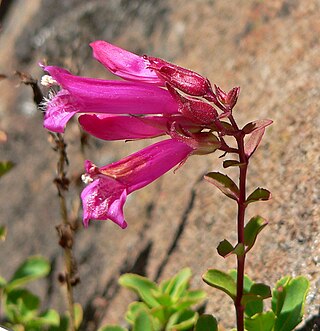
Penstemon newberryi is a species of penstemon known by the common name mountain pride or Newberry's penstemon. It is native to the mountains of northern California, Oregon, and Nevada, where it grows in rocky habitat, often at high elevation, such as talus. It is a bushy, mat-forming subshrub growing up to 30 centimetres tall. The leaves are mostly basal on the plant, oblong or oval and toothed, measuring 1 to 4 centimetres in length, with a few smaller pairs along the stem. The glandular inflorescence bears showy magenta flowers 2 to over 3 cm in length. The flower is generally tubular or funnel-shaped and has a coating of short to long and curly hairs in the mouth and on the staminode.

Phlox caespitosa is a species of phlox known by the common name tufted phlox. It is native to western North America from British Columbia through the Great Basin to New Mexico, where it grows in scrub, woodland, and other open plateau habitat. It is one of several cushion-forming species that occur in the same region and require careful observation to distinguish. In the past, this species and Phlox douglasii have been erroneously lumped together.

Hypoestes phyllostachya, the polka dot plant, is a species of flowering plant in the family Acanthaceae, native to South Africa, Madagascar, and south east Asia. The spots often merge into larger areas of colour.

Silene douglasii is a species of flowering plant in the family Caryophyllaceae known by the common name Douglas's catchfly.

Cyclamen mirabile, sowbread, is a species of flowering plant in the primrose family Primulaceae. A tufted, tuberous herbaceous perennial growing to 10 cm (3.9 in), it is native to Turkish pine woodland and maquis in southwestern Turkey. It belongs to the Cyclamen cilicium group of the genus Cyclamen. The species was identified and named in 1906.
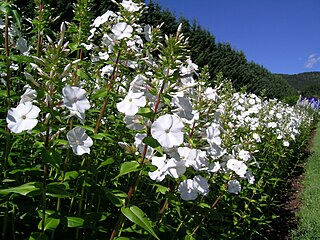
Phlox carolina, the thickleaf phlox, is a species of flowering plant in the family Polemoniaceae. It is an herbaceous perennial growing to 1.2 m (4 ft) tall by 45 cm (18 in) wide, with leaves to 13 cm (5 in) long, and purple or pink flowers in summer. The specific epithet carolina refers to its native habitat in the eastern United States. It grows in woodland edges and openings. Flowers attract bees, hummingbirds, and butterflies.

Phlox maculata, commonly called meadow phlox, as well as wild sweet William and marsh phlox, is a species of flowering plant in the family Polemoniaceae, native the eastern United States and introduced to eastern Canada. It is a perennial.






















